It is quite possible to install an automatic washing machine in a house where there is no running water. Your task is to ensure that a sufficient amount of water enters the machine, as well as to ensure that waste water can be drained.
To implement one of the options for such a connection, you will need vibration pump type “Fontanelle”, “Baby” or other similar model. In addition, you should purchase a container large enough to create a supply of water for washing. To better understand the connection principle, let’s understand the operating principles washing machine.
When a command to draw water is received, a special electric valve in the machine opens and water intake begins. Once a sufficient amount of water has entered the machine’s tank, the valve closes and water intake stops. When opening the valve, it is necessary to ensure automatic switching on a pump that will supply water to an automatic washing machine from a container. And when the valve closes, the pump should be turned off so that the water supply stops.
To automate this process, a conventional electromagnetic relay is used, which is included in the system between the solenoid valve and the pump. The use of such a relay allows you to remove unnecessary load on the programmer of the automatic washing machine. The absence of this device may lead to an overload of the contact group of the programmer, due to which the equipment may simply burn out. For the “Baby” pump, a 5 A relay is quite suitable.
When a command is received to open the solenoid valve of the washing machine, the relay transmits an impulse to the pump and it turns on. The washing machine begins to fill with water. When the valve is turned off, the relay transmits a pulse again and turns off the pump, and the water supply stops. The connection diagram is very simple, it is not difficult to implement.
The diagram shows the procedure for connecting a washing machine if there is no running water in the house. To automate the process, you will need a special relay
Regarding the pump it is worth mentioning next moment: it must provide enough fast filling washing machine tank with water. The water pressure must be at least 0.5 atm. The fact is that many models of modern machines are equipped with a protective timer that controls the time of water supply to the machine’s tank. If the water flows for too long, the machine programmer displays an error message and the device will have to be disconnected and connected again. Even if there is no such timer, a weak water supply can significantly delay the washing process, and this is not good for either the equipment or the laundry.
Some owners of private houses consider it necessary to place a water tank at a certain height - from two to five meters (second floor, attic, etc.). This solution does not always ensure sufficient water pressure entering the washing machine, although there are no serious objections to placing a water container at a height. In this case, you will still need a pump to pump water not into the machine, but into the container. Or you can fill the tank manually, using a regular bucket, but this is not convenient, because washing usually requires about 100-200 liters of water.
The process of connecting a washing machine in a house without running water is presented in detail in the following video:
As for the sewer system, they connect the machine to it in the same way as in houses with running water. If there is no sewage system, you should stock up on another container, into which you simply lower the drain hose of the washing machine and collect dirty water, drained from the washing machine.
Sometimes you want to live a simple, rural life in the fresh air, among natural nature, and not trees and flowers planted by human hands in the park. Country life is especially attractive for people of Balzac's age, when noisy entertainment and restaurants are no longer needed, on the contrary, you want to sit at home, in the coolness of a gazebo built with your own hands, to be in silence, when you can only hear the sounds of living nature and there is no transport or people talking in it. .
Accustomed to city life and spoiled comfortable conditions City dwellers have difficulty adapting to traveling conditions. If you can somehow manage without a dishwasher and a comfortable shower, then what about washing things?
All modern washing machines are designed to be connected to a centralized water supply, and washing large items by hand is not very convenient. There is a way out: connect the machine without running water, resorting to some tricks.
Options for solving the problem
Depending on the conditions and seasonality of residence, the problem can be solved in several ways:
- drill a well on the site and install a pumping station;
- equip a water tank in the attic or second floor of the dacha and let it flow by gravity into the machine;
- pour water into the machine manually;
- use industrial irrigation water for washing;
- use a well together with a pumping station;
- install a small pump to supply water under pressure.
Well for washing machine
A washing machine cannot operate without a water connection. There must be at least some source of fluid supply. Why not drill a well on the site?
To find out the approximate depth at which there may be aquifer with drinking water, you need to contact the companies involved in drilling wells in the area. They have a map of the location of water resources, and even without preliminary surveys they can tell how many meters they will have to drill with a drill.
Water from the well is supplied under good pressure. When using an external pump ( pumping station) the entire house will be connected to the water supply, and the pressure will be enough for a washing machine, dishwasher, boiler and other equipment that increases our comfort.
The main disadvantage of this method is not the cost, but the maintenance of the well. If this country cottage area, used only in the summer, then drilling a well is impractical. It can silt up after several months of inactivity, and before starting operation it will have to be pumped for a long time.
Water tank in the attic
If you have an attic or second floor, you can install a water tank there. Water released by gravity from a height of 5 meters or more will create the minimum necessary pressure for the washing machine to operate. Connecting an automatic machine without running water will be possible.
Disadvantage of this method: you will have to carry water into the attic in buckets. In addition, to prevent the tank from freezing, if it is located in the attic, you will have to drain all the water from it at the end of the season and dry it thoroughly. This method is too labor-intensive and impractical.
Adding water manually
Water can be added to the washing machine through the washing powder container. In top-loading machines, the container for powder and conditioner is located under a lid that is locked when the wash starts. Therefore, adding water is possible if the machine is horizontal loading.
Disadvantages: as soon as the required amount of liquid does not get into the machine, it stops working. It is extremely inconvenient to add water all the time - you will have to stand next to the machine for the entire washing cycle.
We use water for irrigation
If the cooperative has its own pumping station and watering is carried out, you can buy a washing machine for your dacha without running water. The water pressure will be sufficient for the operation of all systems of the automatic machine. The advantages of the method are that the machine can be installed anywhere, even on the street, under covered canopy. At the end of the season, it needs to be brought into the house, and that’s it.
Disadvantages: the operation of the machine will depend on the supply of irrigation water. Process water is often supplied several times a week, by the hour. To wash with such water, it is necessary to install a filter to clean the water from sand and algae particles before supplying it to the equipment.
If there is a well
A well differs from a well in the method of extracting water and its depth. Water can be drawn from a well without a pump, using an ordinary bucket. But if you install a pumping station that creates the necessary pressure, you no longer have to wonder how to install a washing machine without running water.
Disadvantages: the need to purchase an expensive pump. The well's resources are limited, and its water reserves may not be enough to service hard-working equipment.
Installing a small water pump
If all the previous methods are not suitable, then you need to decide how to connect an automatic washing machine without running water. To do this, you will need to make some design changes in the equipment by purchasing an additional pump and the necessary adapters. There are several ways to remake equipment, let's look at the most popular of them.
Converting a washing machine to work without running water
Method 1
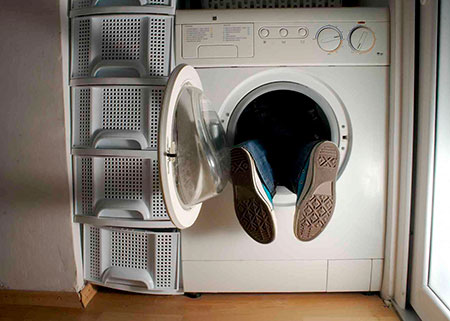 The simplest way to solve the problem is to install any vibration pump and an electromagnetic relay. What does that require:
The simplest way to solve the problem is to install any vibration pump and an electromagnetic relay. What does that require:
- 50 liter barrel or pan.
- Automatic machine with solenoid valve.
- Any vibration pump, maybe from old washing machines.
- Electromagnetic relay, matching the power of the pump.
- A piece of hose connecting the barrel to the machine.
How it works: the relay is installed between the pump and the solenoid valve of the machine. The washing machine uses a programmer to operate the valve, which starts the water supply. In the case of such an assembly, a relay is activated simultaneously with the valve, which sends a pulse to the pump. The pump will turn on and run until the program sends a signal to close the valves. Again, the relay is activated and the pump turns off. The valves are closed - the machine washes quietly.
Method 2
Take a sealed container (large canister, plastic barrel) or any plastic barrel with a gasket for a tight fit of the lid, with two mortise nipples, one at the top, the other at the very bottom. Water is poured into the barrel, but not the full capacity, and pressure is pumped through the upper nipple by a compressor.
A hose is connected to the lower nipple to supply water to the machine. There is enough pressure in the barrel for normal operation of the machine; you only need to check it during washing and pump up the pressure if necessary. A huge advantage of this method: you do not need to make any changes to the design of the machine. This method is good as a temporary solution until the water supply is installed in the house.
Method 3
Buy or take a regular surface pump (garden), pressure regulator, hose adapters, tee. A hose with check valve. The other end is connected to a garden pump, at the outlet of which there is another valve, after which there is a tee for the hose to the machine and a pressure regulator. The asking price is $25-30 for all spare parts including the pump.
Method 4
If the question remains: how to convert an automatic washing machine to work without running water, move on to the next option. To implement it you will need the cheapest garden hose, 2 fittings, popularly called “American”, clamps of suitable diameters, a water container.
The water tank should be slightly higher than the level of technology, at least a meter. The thread of the fitting must be of the appropriate diameter to the hole from the tank and the inlet hole in the machine. Sequencing:
- unscrew the protective mesh installed to filter incoming water;
- screw the threaded fitting into that place;
- We pull the purchased hose onto it, after putting on the clamp. Tighten the clamp tightly;
- We screw the fitting into the tank, put the other end of the hose on it, also securing it securely with clamps.
How larger diameter hose, the stronger the applied pressure. In such conditions, the machine will draw water more slowly, but will still work. The asking price is $5-8.
Method 5
This method is for those who have a car and a garage with a bunch of spare parts lying around. You need a battery charger and any car pump that pumps fluids in vehicles. Using a pump included in the charger, water is pumped from the barrel into the machine. The pump must be below the bottom of the barrel. The disadvantage of this method is that the pump does not turn off, so you will have to constantly monitor it and turn it off on time.
How to choose the right machine for working in the field
How to buy a washing machine without connection to running water? The answer depends on several factors:
- Will the machine be operated with normal water supply in the future?
- Is a valid warranty required for the purchased unit (opening and making any changes will void the warranty).
- What will be the method for connecting the machine without running water?
In many washing machines trademark Gorenje installed pumps for water intake, and not valves, as in other machines. Therefore, they cannot be connected using the first method.
If you buy a washing machine for a summer house without running water, and in the future it will only be used in field conditions It’s simple: any design changes can be made to the technology. But if you need to buy a washing machine without running water, expecting to use it under normal conditions in the future, you need to carefully weigh all the nuances of the connection. It is better to choose a method in which you do not have to interfere with the design of the machine, but use additional external devices: pumping stations, sealed pressure barrels, gravity-fed water barrels.
Conclusion: a washing machine without running water can work if you have a strong desire to improve your life. You can always find ways to connect it, the main thing to remember is the rule: if you don’t understand electrics, don’t interfere. Inept actions to connect additional electrical appliances can not only burn the equipment, but also lead to fires and short circuits in the electrical network.
After all, ready-made washing machines for dachas are now being sold. Their design includes a special tank into which water is poured, and the machine draws from it. If there is no craftsman in the family, it is better to buy a ready-made automatic washing machine to work without running water.
How to connect and use an automatic washing machine in a country house or in a private house without running water?
There are several options for supplying water to the washing machine in the absence of incoming water, for example, the following:
As needed pour water into the machine manually. Minus: you need to be near all the time washing machine and monitor the washing process.
Water flows by gravity, for this install a water tank at a height of at least 4 meters. 1 bar is the minimum pressure that should be in the water supply according to the instructions. Minus: It is a labor-intensive task to fill the tank with water at such a height.
Installation of a pumping station. Expensive, but if you live in a private house or in a country house all year round, the costs will be worth it.
Installing a small injection pump between the water tank and the washing machine. This option is more suitable. Connection diagram: tank - pump - washing machine hose.
Buy: pump for draining water (~700 RUR), adapters for 3/4, which are put on the pump, a tube with silicone sealant for securing the adapters, 1.5-2 meters of two-core wire for connecting the pump.
Cut a hole in the water tank to install an adapter, which is placed on the sealant, and left to dry for a day.
Connection:
To better hold the sealant, the tubes on the pump are cleaned with coarse sandpaper to connect them to the adapters. Lubricate with sealant and put on the adapters. The wire to the contacts can be connected with clamps or soldered, and the connections can be protected with heat-shrinkable tubing. The sealant should dry and the pump is almost ready for use.
Now you need to connect the pump to the tank and to the washing machine, pour water into the tank and start the wash cycle. When the washing machine needs water, the pump turns on at 220V, water is successfully pumped from the tank to the machine.
You can force the washing machine to turn on the pump on its own. For this:
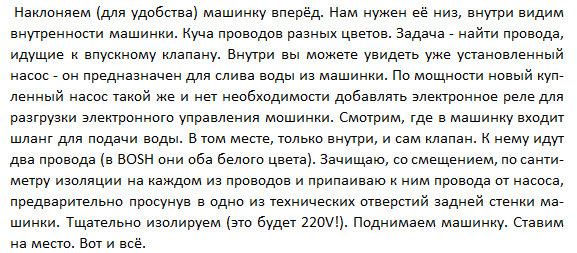
There is only one answer - you need to supply water to the machine from somewhere, if the drainage can simply be taken out into the garden, then the problems with water are completely different.
The first problem is that the machine has an electric valve, which will not open completely without water pressure, that is, it must be pressed on one side by water, and in the line it is under pressure of at least 2 atmospheres, and an electromagnet must open it completely.
Problem two is approximately 100 liters of water for full cycle washing (plus or minus), they need to be supplied to the machine from somewhere, respectively, applied somewhere and from somewhere.
The second problem is easier to solve - for example, they found two hundred liter barrel and there is a well in the yard.
The first problem involves creating water pressure to supply it to the automatic machine. Many people advise installing a pump, but is it possible to do without it? Yes you can, but you must observe the following!
The first container will have to be raised at least 4 meters from the level of water intake (washing machine fitting), that is, placed in the attic or specially built, practically a water tower.
The second is to supply water to the machine with a pipe with a diameter of at least 3/4, and preferably an inch.
If these two conditions are met, the machine will work without problems, and it will work even with the container raised two meters, but it takes too long to draw water, and accordingly there is an excessive consumption of electricity, and the valve, due to long compression by the electromagnet, may eventually come out of building.
There are many different options.
- If you have a well, some kind of reservoir or borehole, you can install a pumping station and connect a washing machine to it.
- If you have nothing, and you bring water from afar in buckets, it makes sense to install a tank that will be located above the level of the machine, with a pipe running from the tank to the machine.
- There are also special machines with a water tank especially for those who do not have central water supply.
Instructions
To connect the washing machine car through the well, you just need to call drillers, lay pipes and install a pump with storage tank. You will connect the washing machine car-automatic machine in exactly the same way as if there was a central water supply. Can be connected to the well dishwashers, titans, toilets, showers. That is, one well completely replaces the central system water supply. But there is one drawback. The entire installation system is quite expensive and if you are not willing to incur significant costs, then use other, cheaper options.
The second option is to connect the automatic machine from the well. To do this, run pipes from the well, install a pumping station and connect the water supply to the washing machine. But before the filling hose, install an additional mechanical or magnetic filter, since water from the well may contain sand and other foreign particles, which will quickly damage the machine. If this option does not suit you, then you can use another method.
Place the container above the level of the washing machine. A capacity of 100-150 liters is sufficient for one washing cycle. To ensure that the water supply is high-pressure, which is required for most models of modern automatic machines, connect the water supply to car through the pumping station. If you do not plan to connect the pump, install the machine without controlling the water fill time. She doesn't need high pressure, and it will work normally without pressure.
And the last option is to pour water through the powder compartment, but in this case you can connect a machine with a lower measurement of the water level in the tank. If there is a top level of control, then this method will not work, since the machine will constantly confuse the program and fail.
Modern washing machines - machine guns They are not cheap, and their owners also have to pay for delivery and installation. However, on the last point it is quite possible to save money by connecting typewriter on one's own.
You will need
- the washing machine you are going to connect, components, siphon, water splitter.
Instructions
Place the washing machine in the place where you will connect it and remove the transport bolts.
Assemble and install the siphon. This is quite easy to do, because modern equipment both imported and domestic production are included detailed instructions. You will need a siphon with a special outlet for the washing machine.
Insert a gasket into the water splitter, then install it between the flexible hose that goes to the mixer and the pipe with cold water. Before installing the splitter, be sure to turn off the water.
Open the main valve to make sure there are no leaks. If there is still a leak, slightly tighten the nut of the hose or splitter.
Screw to the outlet a hose designed for collecting water, which comes from the washing machine.
Adjust the height drain hose. It must be at a height of at least 80 centimeters from the floor.
Adjust the position of the washing machine. To do this, place a level on its surface and tighten the legs of the machine. Then turn the level perpendicularly and repeat the adjustment.
Traveling out of town for the summer season can be marred by the need to do laundry in the absence of running water. Knowing how to connect a washing machine without running water, you can save yourself from this problem.
How does a washing machine work?
The washing process in modern washing machines fully automated - filling and heating water, adding detergents, rinsing, spinning, draining waste water, occurs according to a given program.
If the programs are varied and depend on the model of the washing machine, then the principle of operation in them is almost the same.
Water enters the detergent compartment, then is poured through a rubber pipe into the tank, inside of which the drum rotates. After washing, waste water is removed into the sewer using a drain pump.
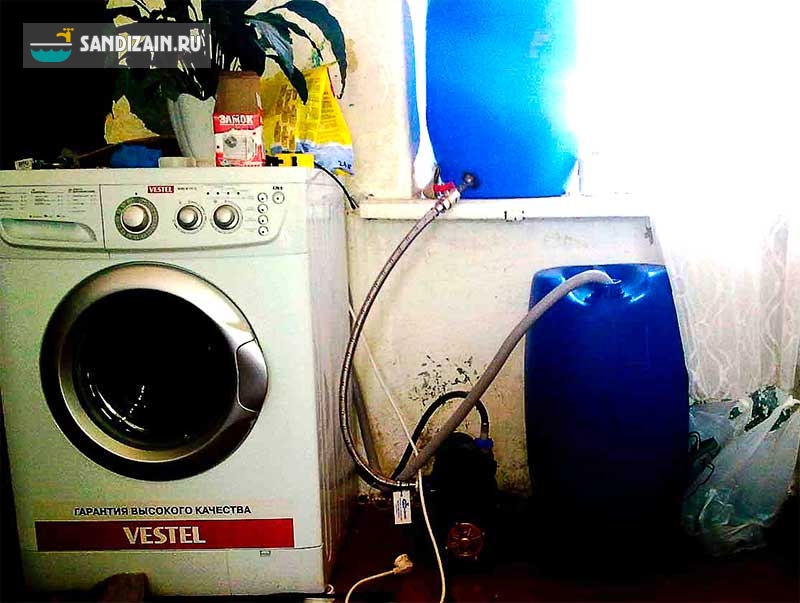
Water enters the washing machine through solenoid valve, which opens under the influence of electricity. In this case, the water must flow under pressure. If there is insufficient pressure in the system, water either does not fill in, or the washing program is disrupted, and the machine fails.
If in an apartment the problem of water supply is solved by a regular connection to the water supply system, then in a country house this is not always possible.
Options for organizing water intake
A washing machine in a country house without running water can be used if a water supply is provided under pressure. This can be done in several ways:
1. Add water manually. With this method, water is added through the detergent compartment. A significant drawback of this option is that after completing each program, the washing machine will stop; to continue, you need to add water. This is a labor-intensive process that takes a lot of time.
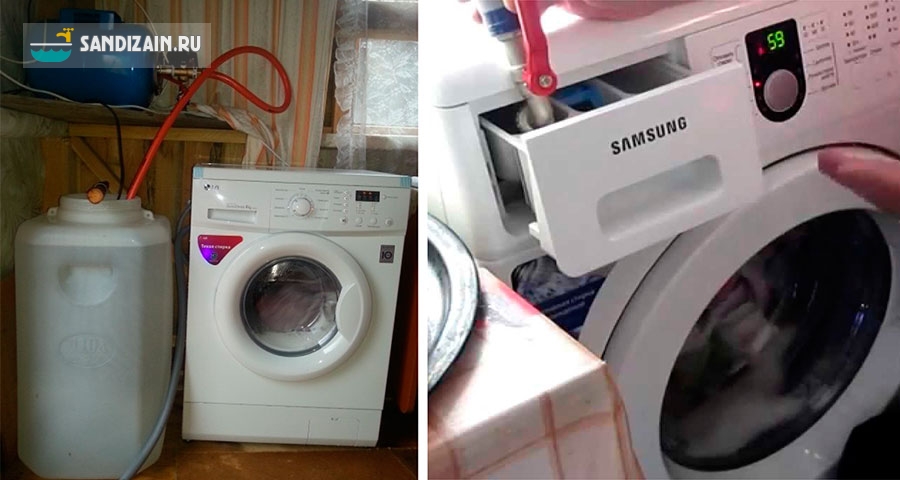
2. Installation of a pumping station. Quite an expensive option. If the dacha is used only in the summer and you only need to connect a washing machine, then the costs are not always justified. In addition, the pumping station requires a source with clean water, which is not always available at the dacha.
3. Artificial creation pressure. This can be done by placing the water tank significantly above the level of the washing machine. Ideally this is 8-10 meters. If the house has two floors or an attic, then this is quite feasible. The disadvantages of this method are that you need to carry water to the second floor.
4. Imitation of a pumping station. It is created by installing a small pump between the water tank and the washing machine. Most the best way, which does not require large financial investments.
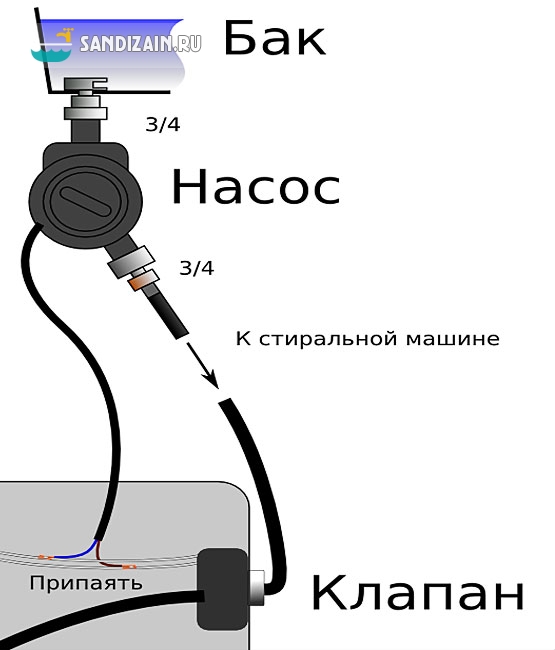
Installing a washing machine
A washing machine in a country house without running water can be installed in any room where it is possible to connect a pump. It should be borne in mind that waste water must be drained somewhere, which means a special container or drainage system will be required.
If you have a hose of sufficient length, then the easiest way is to take it out into the yard and drain it into a pre-prepared hole.
Important! Before starting the washing machine, check that the transport bolts have been removed from the drum. If this is not done, the washing machine will malfunction when first started.
When deciding how to connect a washing machine, you should pay attention to a method that simulates a pumping station. To implement it you will need a small amount Supplies, as well as a regular pump - submersible, drainage, and any other used in the country.
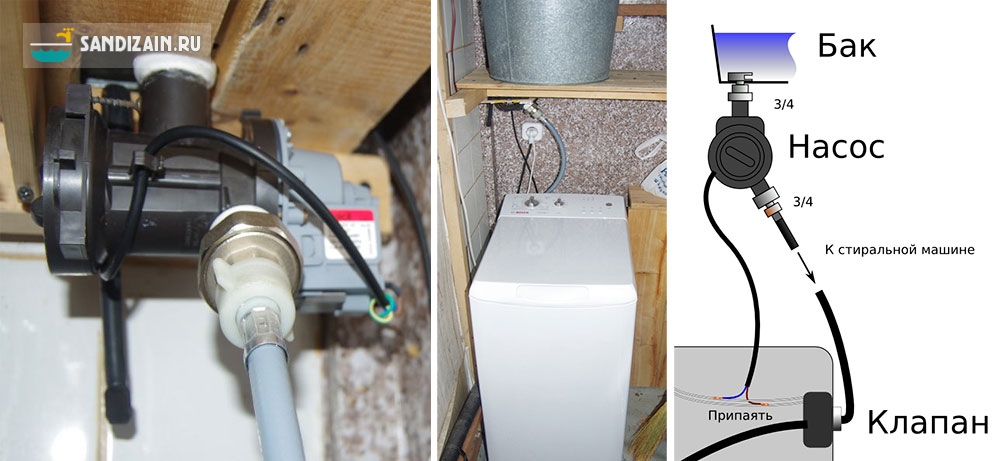
Materials required for connection:
- pump;
- a barrel or other container for water;
— relay for turning on/off the pump;
— consumables: valve ball, tee, fitting, adapters, fum tape.
If you don’t yet have a washing machine, then for your dacha it is recommended to choose one with a small volume and, accordingly, low water consumption (about 40 liters per cycle). Depending on this, the water container is also selected. For such a volume, a barrel of 100-110 liters is enough.
You can connect an automatic washing machine without running water as follows:
A system consisting of a pump, pressure switch, and hose is assembled. This is all connected using a tee, from which one hose goes to the washing machine, the second to the pressure switch, and the third to the pump. The wires from the pressure switch (there are only two of them) are connected, respectively, to the pump and to a 220V network.
The principle of operation of the relay is as follows: when the relay is closed, there is no pressure in the hose, the pump works to create this pressure. When the washing machine opens the solenoid valve to fill with water, the pressure in the system drops and the relay is automatically activated.
This, in turn, starts the pump, which pumps water into the machine. When the drum is filled with sufficient water, the solenoid valve closes and the relay sends a signal to the pump again, this time to turn it off.
Important! When connecting all parts and hoses, it is necessary to use fum tape and sealant to avoid water leaks and short circuits.
The pressure switch is a rather expensive unit, therefore, if you wish and have electrical knowledge, you can do without it. There are two options for replacing it:
— connection directly to the electrovalves of the washing machine. To do this, you will need to assemble a circuit that connects to the valves and works when at least one of them is open. To carry out this task, you will need to open the lid of the washing machine;
— connection using reed switches (contacts in a glass bulb). The reed switch will trigger and transmit a signal to the pump to turn on when the valve opens and a magnetic field is created around it. To implement this scheme, you do not need to open the machine.
Important! Since the motor vibrates strongly during operation, it must be installed at a distance from a plastic container, for example, it can be suspended above a barrel.
When the circuit is ready, connecting an automatic washing machine without running water can be considered complete. You just need to fill the container with water and lower the hose into it.








